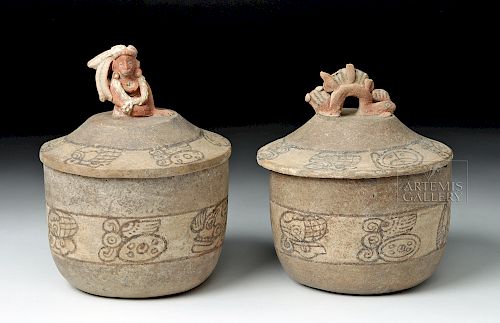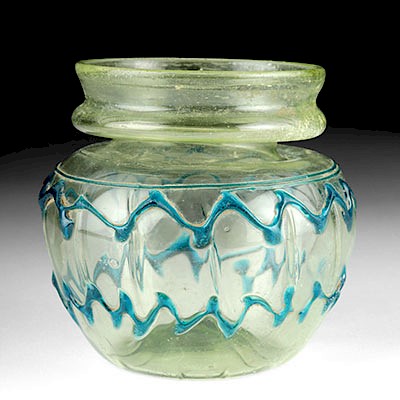Mayan Pottery Lidded Cache Vessels - Matched Pair
Lot 163
About Seller
Artemis Fine Arts
686 S Taylor Ave, Ste 106
Louisville, CO 80027
United States
Selling antiquities, ancient and ethnographic art online since 1993, Artemis Gallery specializes in Classical Antiquities (Egyptian, Greek, Roman, Near Eastern), Asian, Pre-Columbian, African / Tribal / Oceanographic art. Our extensive inventory includes pottery, stone, metal, wood, glass and textil...Read more
Estimate:
$7,000 - $9,000
Absentee vs Live bid
Two ways to bid:
- Leave a max absentee bid and the platform will bid on your behalf up to your maximum bid during the live auction.
- Bid live during the auction and your bids will be submitted real-time to the auctioneer.
Bid Increments
| Price | Bid Increment |
|---|---|
| $0 | $25 |
| $300 | $50 |
| $1,000 | $100 |
| $2,000 | $250 |
| $5,000 | $500 |
| $10,000 | $1,000 |
| $20,000 | $2,500 |
| $50,000 | $5,000 |
| $100,000 | $10,000 |
| $200,000 | $20,000 |
About Auction
By Artemis Fine Arts
Aug 16, 2018
Set Reminder
2018-08-16 10:00:00
2018-08-16 10:00:00
America/New_York
Bidsquare
Bidsquare : Clearance Sale - Ancient / Ethnographic Art
https://www.bidsquare.com/auctions/artemis-gallery/clearance-sale---ancient-ethnographic-art-3368
These lots are going, going, gone... plus a nice selection of lots brand-new to auction! Artemis Fine Arts info@artemisfinearts.com
These lots are going, going, gone... plus a nice selection of lots brand-new to auction! Artemis Fine Arts info@artemisfinearts.com
- Lot Description
**Originally Listed At $3650**
Pre-Columbian, Mexico and northern Central America, Mayan Territories, Late Classic, ca. 550 to 900 CE. An incredible matched pair of lidded ceramic vessels of the style found in buried caches. The lid of one vessel is capped by a handle in the form of a fish, and the other is capped by a handle in the form of a seated monkey dressed in finery, including a large garland-style necklace, big spool earrings, and a feathered headdress, a symbol of royalty. Around the rim of each lid is a series of black-outlined glyphs (each vessel has six different glyphs) including symbols for water, human skull, and different animals. The bodies of the vessels are elegant, undecorated aside from a band around the center of their exteriors, with the band sparsely filled with six more black-outlined glyphs. The vessels themselves are steep walled, with slightly convex bases, gently flaring out to an unpronounced rim. The lids sit atop them, held in place by a slight rim. Size of largest with lid (monkey vessel - though they are close in size): 5" W x 6.7" H (12.7 cm x 17 cm)
Unlike many other ancient civilizations, the Mayans did not have cemeteries or necropolises; instead, they buried both human remains and ritual caches of pottery filled with offerings, jade, beads, and other precious items throughout their lived-in-landscape, especially as part of their architecture. These all seem to have been "earth offerings," and may have been dedications for newly built construction, markers for the end of use of a building, or some kind of renewal ceremony relating to the broader concept of Mayan cosmology: the cycle of planting, harvest, and rebirth. Caches have been found in floors, in the fill of buildings, or set into walls. Vessels with lids seem to have been symbolic of houses or structures to the Maya, meaning that these vessels served as effigies of the buildings they were buried inside, able to be filled with offerings of food or drink, sanctifying the construction. These are particularly nice examples, as many vessels made only to be cached are of thin construction because they were never meant for heavy use. The glyphs that cover their surfaces probably describe the relationship between the lived-in world that the Maya inhabited and the mythological, religious world in which they believed.
Provenance: private Lexington, Kentucky, USA collection
All items legal to buy/sell under U.S. Statute covering cultural patrimony Code 2600, CHAPTER 14, and are guaranteed to be as described or your money back.
A Certificate of Authenticity will accompany all winning bids.
We ship worldwide and handle all shipping in-house for your convenience.
#131052Lid with lizard has been repaired from two pieces, with expert restoration along the repair lines that make it almost impossible to discern. The lower part of that vessel has also been repaired and restored from two pieces. Gorgeous root marks on its interior. Tiny chip from underside of lid and small chip from rim of vessel. Both lid and body of vessel have light deposits and beautifully preserved pigments. The lid of the other vessel (monkey) has been repaired and restored from about four pieces, with overpainting along the restoration lines that is almost impossible to see, especially on the upper side. One very thin crack on edge of lid has also been repaired, and makes it a little fragile. The body of this vessel has also been repaired and restored with overpainting from what looks like three or four large pieces. Repairs are essentially invisible on the exterior. Root marks and deposits on both lid and body. Beautiful preservation of glyphs on each component.Condition
- Shipping Info
-
All shipping is handled in-house for your convenience. Your invoice from Artemis Gallery will include shipping calculation instructions. If in doubt, please inquire BEFORE bidding for estimated shipping costs for individual items.
-
- Buyer's Premium



 EUR
EUR CAD
CAD AUD
AUD GBP
GBP MXN
MXN HKD
HKD CNY
CNY MYR
MYR SEK
SEK SGD
SGD CHF
CHF THB
THB

















